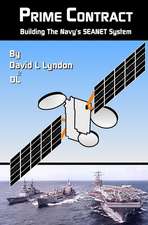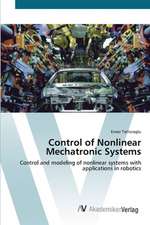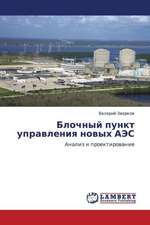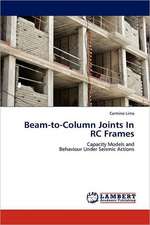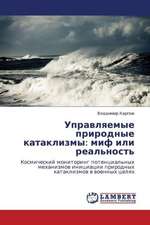Emergency Management for Facility and Property Managers
Autor Richard Payanten Limba Engleză Hardback – 16 apr 2016
Understand, Plan, and Prepare for Emergencies and Disasters
Develop and implement effective emergency management plans throughout your organization using the detailed information contained in this practical guide. Emergency Management for Facility and Property Managers shows, step-by-step, how to minimize property damage, reduce the risk of personal injury, and ensure business continuity—all while complying with the plethora of laws and regulations. You will get up-to-date coverage of the many types of emergencies, the elements of successful emergency management, and employee and family preparedness. Valuable appendixes contain helpful forms and checklists, facility and property intelligence data, and a complete sample emergency management plan.
Preț: 832.41 lei
Preț vechi: 1015.13 lei
-18% Nou
Puncte Express: 1249
Preț estimativ în valută:
159.28€ • 166.75$ • 131.79£
159.28€ • 166.75$ • 131.79£
Carte tipărită la comandă
Livrare economică 05-19 aprilie
Preluare comenzi: 021 569.72.76
Specificații
ISBN-13: 9781259587665
ISBN-10: 1259587665
Pagini: 432
Dimensiuni: 196 x 218 x 31 mm
Greutate: 0.95 kg
Editura: McGraw Hill Education
Colecția McGraw-Hill
Locul publicării:United States
ISBN-10: 1259587665
Pagini: 432
Dimensiuni: 196 x 218 x 31 mm
Greutate: 0.95 kg
Editura: McGraw Hill Education
Colecția McGraw-Hill
Locul publicării:United States
Cuprins
Part I Elements of Emergency Management for Facility and Property Managers
1 Categorizing and Managing Emergencies
Emergencies to Disasters
Facility Risk Concerns
Categorizing Emergencies
Evaluating Risk
Preparedness and Risk
Effective Plans
Recommended Assessment
Initial Steps for Managing Emergencies
End of Chapter Review Questions
Notes
2 Emergency and Disaster Planning, Organizing, and Responsibilities
Planning
Emergency Management Plan Characteristics
Emergency Management Planning Sequence
Emergency Management Planning Levels and Standards
Planning Meetings
Emergency Response Flowchart
Organization
Purpose
Organizational Considerations
Organizational Structure
Emergency Management Responsibilities
Facility and Property Manager Responsibilities
Emergency Security Responsibilities
End of Chapter Review Questions
Note
3 Mitigation and Damage Assessment
Mitigation
Factors of Mitigation
Strategies for Mitigation
Improve Facility and Property Survivability Through Mitigation
Windows
Roofing Systems
Lightning Protection Systems
Information for First Responders
Guidelines for Facility- or Property-Specific Plans
Facility or Property Intelligence
Damage Assessment
Damage Assessment Concept
Damage Assessment Surveys
Damage Assessment Categories
Damage Assessment Team Composition and Responsibilities
Damage Assessment Information Sources
Damage Assessment Logistics Considerations
Damage Assessment Documentation
End of Chapter Review Questions
Note
4 Response, Recovery, and Business Continuity
Response to an Emergency
Stages of Emergency Response
Response Organization
Supplies, Services, and Contracts
Recovery
Recovery—General Concept
Recovery—Responsibilities
Recovery Planning
Recovery—Facilities Restoration
Business Continuity
What Is Business Continuity?
Benefits of Business Continuity Planning
Business Continuity and Budgets
Strategies for Business Continuity
Business Continuity Standards
End of Chapter Review Questions
Note
5 Emergency Management Training for Facility and Property Management
Training
Education of Employees, Visitors, and Students
Training of Facility and Property Management Employees
Training Assessment
Training Materials and Awareness
Training Objectives
Facility and Property Management Team Training
First Responder Training
Tests, Table Tops, Training Exercises, and Drills
End of Chapter Review Questions
Note
6 Command, Control (Evacuation or Shelter-in-Place), and Communications
Command
Chain of Command
Onsite Authority
Control
Succession Responsibility
Facility Emergency Operations Center (FEOC)
Structure of the Facilities Emergency Operations Center
Functions of the Facilities Emergency Operations Center
Physical Configuration of the Facilities Emergency Operations Center
Startup of the FEOC
Support Services
Communications
Purpose of Communications
Communications Plan
Communications Before an Emergency
Communications During an Emergency
Communications After an Emergency
Communications Dos and Don’ts
Emergency Communications
Mobile Devices and Social Media
Virtual Communications
Mass Notification
Evacuation
Concept of Operation
Administration and Logistics
Accounting for Personnel After Evacuation
Evacuation Planning Procedures
Evacuation Action Procedures
Shelter-in-Place
End of Chapter Review Questions
Notes
7 National Incident Management System
National Incident Management System (NIMS)
Incident Command System (ICS)
ICS Features and Principles
Reliance on Planning and Incident Action Plans
Incident Management Roles
ICS Benefits
Emergency Support Functions
End of Chapter Review Questions
Part II Types of Emergencies
8 Electrical Power Emergency
Introduction
The Need for Emergency Power
Emergency Power Recovery Plans
Emergency Generators
Placement and Specifications
Reliability
Generator Power and Capacity
Generator Set Location
Fire Separation
Emergency Feeders
Engine Selection
Provisions for Expansion
Protective Coordination
Voltage and Frequency Requirements
Managing Emergency Power Load Growth
Engine Generator
Generator Set Sizing
Advantages and Disadvantages of Diesel-Driven Generators
Batteries
Uninterruptible Power Supply (UPS)
The Risk
Management Checklist
End of Chapter Review Questions
Note
9 Elevators and Escalators
Introduction
Purpose
Elevator Basics
Regular Operating/Cleaning Checks
Safety Guidelines
Safety Codes
Minimize Accidents
Performance Response Times
Emergency Procedures
End of Chapter Review Questions
10 Fire Protection
Importance of Fire Prevention
Systems and Procedures
Command and Control
Record Keeping
Preplanning
Fire Brigade
Coordination with Outside Agencies
Management
Assessment
Fire Prevention
Fire Plan
Controlling Fire Emergencies
Evacuation
Assembly Areas
Account for Personnel
Fire Exits
Fire Protection
Fire Protection Equipment
Fire Control
Fire Detection and Suppression Systems
What to Do After a Fire
Physical Plant Security and Traffic
Communication
First-Aid Firefighting Equipment
End of Chapter Review Questions
Note
11 Hazardous Materials/Spills Emergencies
Hazardous Materials
What Is Hazardous Material?
Elements of a Hazardous Materials Management Program
HAZMAT Inspection
Hazardous Material Plan
Globally Harmonized System (GHS)
Assessment
Production and Storage
Required Care and Management
Containers and Tanks
Personal Protective Equipment (PPE)
Sharps
Bloodborne Pathogens
Refrigerant Accountability
Hazardous Waste Disposal
Hazardous Waste Emergency Preparation
HAZMAT Emergency Response
Individual Response to a HAZMAT Incident
Procedures for Cleanup (The Fire Department HAZMAT Team Is Experienced with This.)
Hazard Communication: Elements of a Written Communication Program
Specialized Materials and Chemicals
Storage, Handling, and Disposal Precautionary Procedures
End of Chapter Review Questions
Notes
Additional Resources
12 Indoor Air Quality
Pollutants
Minimize Pollutants
Preventive Actions
IAQ Facility Inspections
Objective
Facility Inspection Method
Operations
Maintenance
Custodial Services
Source Management
Space Layout
Policy
End of Chapter Review Questions
Additional Resources
13 Labor Strike Plan
Labor Strikes in General
Early Planning
The Strike Plan
Poststrike Recovery
End of Chapter Review Questions
14 Storm and Weather Preparedness
Weather Preparedness
Policy
Winter Storm Applicability
Responsibility
Winter Weather Preparations—Before
General Preparations
Building Preparations (Interior and Exterior)
Cold Weather and Fire Protection Equipment
Snow and Ice Storm Response
Snow and Ice Preparedness Time Line
Deicing Material
Departure from Policy
Winter Weather Response—During
Buildings and Grounds
Building Closure Due to Loss of Heat
Debris Removal and Deicing of Pavements, Sidewalks, and Staircase Priorities
Summer or Other Storms
Electrical Storms
Lightning
Flooding
High Winds
Solar Storms
After the Storm
Management Checklist
End of Chapter Review Questions
Notes
Additional Resources
15 Natural Disasters
Natural Disasters
Hurricanes
Hurricane Advisories
Preparations Before a Hurricane
Equipment and Support Needed
Tornadoes
Before Tornado
Danger Signs
Shelter
Checklist
Equipment and Support Needed
Earthquakes
Seismic Building Resilience
Preparations Before an Earthquake
Actions During an Earthquake
Actions After an Earthquake
Tsunami
Tsunami Mitigation
Volcanic Eruptions
Surviving a Volcanic Eruption
End of Chapter Review Questions
Notes
16 Infectious Disease Emergencies
Infectious Disease Management
Definition of Infectious Disease
Types of Microbes
Pandemic Severity Index (PSI)
Cleaning, Sanitizing, and Disinfecting
Comprehensive Cleaning Program
Prevention of Infectious Disease Outbreak
Maintenance of Building Systems
Building Envelope
Air-Handling Systems
Importance of Air Filtration
MASS CARE
Purpose
Assumptions
Concept of Operation
Administration and Logistics
Education and Communication
End of Chapter Review Questions
Notes
17 Physical Security
Facility Physical Security
Physical Security Challenges
Physical Security Planning
Protective and Security Methods
Natural Deterrents
Structural Deterrents (Barriers)
Other Deterrents
Role of Professionals (Responsibilities)
Security or Emergency Manager
Facility and Property Managers
Crime Prevention Through Environmental Design (CPTED)
End of Chapter Review Questions
Notes
Additional Resources
18 Control of Hazardous Energy (Lockout-Tagout)
General
Hazardous Energy
Compliance with OSHA Standards
Scope of the Standard
Lockout Procedures
Tagout Procedures
Restoring Equipment/Machinery to Service
Employees and Training
Periodic Inspection by the Organization
Equipment Testing or Positioning
Group Lockout-Tagout
Compliance with Group Lockout-Tagout Procedures
Compliance of Outside Personnel (Contractors, and So Forth)
End of Chapter Review Questions
Note
19 Water Disruption
Introduction: The Big Picture
General Awareness
Examples of Water Impacts
Planning for Water Loss
Water Supply Usage Assessment
Water Supply Alternatives
Develop a Water Supply Plan (WSP)
Emergency Actions
Ways to Purify Water
Boiling
Disinfection
Distillation
Filtration
End of Chapter Review Questions
Notes
Additional Resources
20 Workplace Violence
Introduction
Definition of Workplace Violence
Categories of Workplace Violence
Liability
Planning
Planning Committee
Bargaining Unit (Union)
Planning Process
Policies and Standard Operating Procedures (SOPs)
Preventive and Protective Actions
Workplace Violence Recovery
Training
End of Chapter Questions
Notes
21 Terrorism
Introduction
Definition of Terrorism
Preparations
Nuclear Weapons
Nuclear Explosion Direct Effects
Types of Nuclear Explosions
Nuclear Direct Effects Physical Injury
Protection from Radioactive Fallout
Electromagnetic Pulse (EMP)
How to Prepare
Biological Weapons
Biological Attack Indicators
Defense to Minimize and Reduce Casualties
Biologic Agent Characteristics
Chemical Weapons
Chemical Attack Indicators
Categories of Chemical Agents
Chemical Agent Characteristics
Detection
Protection—If Something Seems Unusual—Treat It That Way!
Necessary Protection Equipment
Decontamination
Mechanical Decontamination
Chemical Decontamination
Expedient Decontamination
Physical Decontamination
Decontamination Equipment
Cyberterrorism
Protecting Building Automation Systems
Agro-Terrorism
Bomb Threat
General
Preparations Before the Threat
Bomb Threat Security Plan
Bomb Threat Response Plan
During the Threat
Describe the Caller’s Voice and Mannerisms
Receiving Letter Threat/Bomb
Threat Decision
Evacuation
Search
After the Threat
Lessons Learned
Crisis Intervention
Leader Recommended Actions
Individual Recommended Actions
End of Chapter Review Questions
Notes
Additional Resources
Part III Employee and Family Preparedness
Part IV Appendixes
A Protocols, Checklists, and Forms
B Facility and Property Intelligence
C Sample Facilities and Property Emergency Management Plan
Part V Resources, References, and Web Sites
Index
1 Categorizing and Managing Emergencies
Emergencies to Disasters
Facility Risk Concerns
Categorizing Emergencies
Evaluating Risk
Preparedness and Risk
Effective Plans
Recommended Assessment
Initial Steps for Managing Emergencies
End of Chapter Review Questions
Notes
2 Emergency and Disaster Planning, Organizing, and Responsibilities
Planning
Emergency Management Plan Characteristics
Emergency Management Planning Sequence
Emergency Management Planning Levels and Standards
Planning Meetings
Emergency Response Flowchart
Organization
Purpose
Organizational Considerations
Organizational Structure
Emergency Management Responsibilities
Facility and Property Manager Responsibilities
Emergency Security Responsibilities
End of Chapter Review Questions
Note
3 Mitigation and Damage Assessment
Mitigation
Factors of Mitigation
Strategies for Mitigation
Improve Facility and Property Survivability Through Mitigation
Windows
Roofing Systems
Lightning Protection Systems
Information for First Responders
Guidelines for Facility- or Property-Specific Plans
Facility or Property Intelligence
Damage Assessment
Damage Assessment Concept
Damage Assessment Surveys
Damage Assessment Categories
Damage Assessment Team Composition and Responsibilities
Damage Assessment Information Sources
Damage Assessment Logistics Considerations
Damage Assessment Documentation
End of Chapter Review Questions
Note
4 Response, Recovery, and Business Continuity
Response to an Emergency
Stages of Emergency Response
Response Organization
Supplies, Services, and Contracts
Recovery
Recovery—General Concept
Recovery—Responsibilities
Recovery Planning
Recovery—Facilities Restoration
Business Continuity
What Is Business Continuity?
Benefits of Business Continuity Planning
Business Continuity and Budgets
Strategies for Business Continuity
Business Continuity Standards
End of Chapter Review Questions
Note
5 Emergency Management Training for Facility and Property Management
Training
Education of Employees, Visitors, and Students
Training of Facility and Property Management Employees
Training Assessment
Training Materials and Awareness
Training Objectives
Facility and Property Management Team Training
First Responder Training
Tests, Table Tops, Training Exercises, and Drills
End of Chapter Review Questions
Note
6 Command, Control (Evacuation or Shelter-in-Place), and Communications
Command
Chain of Command
Onsite Authority
Control
Succession Responsibility
Facility Emergency Operations Center (FEOC)
Structure of the Facilities Emergency Operations Center
Functions of the Facilities Emergency Operations Center
Physical Configuration of the Facilities Emergency Operations Center
Startup of the FEOC
Support Services
Communications
Purpose of Communications
Communications Plan
Communications Before an Emergency
Communications During an Emergency
Communications After an Emergency
Communications Dos and Don’ts
Emergency Communications
Mobile Devices and Social Media
Virtual Communications
Mass Notification
Evacuation
Concept of Operation
Administration and Logistics
Accounting for Personnel After Evacuation
Evacuation Planning Procedures
Evacuation Action Procedures
Shelter-in-Place
End of Chapter Review Questions
Notes
7 National Incident Management System
National Incident Management System (NIMS)
Incident Command System (ICS)
ICS Features and Principles
Reliance on Planning and Incident Action Plans
Incident Management Roles
ICS Benefits
Emergency Support Functions
End of Chapter Review Questions
Part II Types of Emergencies
8 Electrical Power Emergency
Introduction
The Need for Emergency Power
Emergency Power Recovery Plans
Emergency Generators
Placement and Specifications
Reliability
Generator Power and Capacity
Generator Set Location
Fire Separation
Emergency Feeders
Engine Selection
Provisions for Expansion
Protective Coordination
Voltage and Frequency Requirements
Managing Emergency Power Load Growth
Engine Generator
Generator Set Sizing
Advantages and Disadvantages of Diesel-Driven Generators
Batteries
Uninterruptible Power Supply (UPS)
The Risk
Management Checklist
End of Chapter Review Questions
Note
9 Elevators and Escalators
Introduction
Purpose
Elevator Basics
Regular Operating/Cleaning Checks
Safety Guidelines
Safety Codes
Minimize Accidents
Performance Response Times
Emergency Procedures
End of Chapter Review Questions
10 Fire Protection
Importance of Fire Prevention
Systems and Procedures
Command and Control
Record Keeping
Preplanning
Fire Brigade
Coordination with Outside Agencies
Management
Assessment
Fire Prevention
Fire Plan
Controlling Fire Emergencies
Evacuation
Assembly Areas
Account for Personnel
Fire Exits
Fire Protection
Fire Protection Equipment
Fire Control
Fire Detection and Suppression Systems
What to Do After a Fire
Physical Plant Security and Traffic
Communication
First-Aid Firefighting Equipment
End of Chapter Review Questions
Note
11 Hazardous Materials/Spills Emergencies
Hazardous Materials
What Is Hazardous Material?
Elements of a Hazardous Materials Management Program
HAZMAT Inspection
Hazardous Material Plan
Globally Harmonized System (GHS)
Assessment
Production and Storage
Required Care and Management
Containers and Tanks
Personal Protective Equipment (PPE)
Sharps
Bloodborne Pathogens
Refrigerant Accountability
Hazardous Waste Disposal
Hazardous Waste Emergency Preparation
HAZMAT Emergency Response
Individual Response to a HAZMAT Incident
Procedures for Cleanup (The Fire Department HAZMAT Team Is Experienced with This.)
Hazard Communication: Elements of a Written Communication Program
Specialized Materials and Chemicals
Storage, Handling, and Disposal Precautionary Procedures
End of Chapter Review Questions
Notes
Additional Resources
12 Indoor Air Quality
Pollutants
Minimize Pollutants
Preventive Actions
IAQ Facility Inspections
Objective
Facility Inspection Method
Operations
Maintenance
Custodial Services
Source Management
Space Layout
Policy
End of Chapter Review Questions
Additional Resources
13 Labor Strike Plan
Labor Strikes in General
Early Planning
The Strike Plan
Poststrike Recovery
End of Chapter Review Questions
14 Storm and Weather Preparedness
Weather Preparedness
Policy
Winter Storm Applicability
Responsibility
Winter Weather Preparations—Before
General Preparations
Building Preparations (Interior and Exterior)
Cold Weather and Fire Protection Equipment
Snow and Ice Storm Response
Snow and Ice Preparedness Time Line
Deicing Material
Departure from Policy
Winter Weather Response—During
Buildings and Grounds
Building Closure Due to Loss of Heat
Debris Removal and Deicing of Pavements, Sidewalks, and Staircase Priorities
Summer or Other Storms
Electrical Storms
Lightning
Flooding
High Winds
Solar Storms
After the Storm
Management Checklist
End of Chapter Review Questions
Notes
Additional Resources
15 Natural Disasters
Natural Disasters
Hurricanes
Hurricane Advisories
Preparations Before a Hurricane
Equipment and Support Needed
Tornadoes
Before Tornado
Danger Signs
Shelter
Checklist
Equipment and Support Needed
Earthquakes
Seismic Building Resilience
Preparations Before an Earthquake
Actions During an Earthquake
Actions After an Earthquake
Tsunami
Tsunami Mitigation
Volcanic Eruptions
Surviving a Volcanic Eruption
End of Chapter Review Questions
Notes
16 Infectious Disease Emergencies
Infectious Disease Management
Definition of Infectious Disease
Types of Microbes
Pandemic Severity Index (PSI)
Cleaning, Sanitizing, and Disinfecting
Comprehensive Cleaning Program
Prevention of Infectious Disease Outbreak
Maintenance of Building Systems
Building Envelope
Air-Handling Systems
Importance of Air Filtration
MASS CARE
Purpose
Assumptions
Concept of Operation
Administration and Logistics
Education and Communication
End of Chapter Review Questions
Notes
17 Physical Security
Facility Physical Security
Physical Security Challenges
Physical Security Planning
Protective and Security Methods
Natural Deterrents
Structural Deterrents (Barriers)
Other Deterrents
Role of Professionals (Responsibilities)
Security or Emergency Manager
Facility and Property Managers
Crime Prevention Through Environmental Design (CPTED)
End of Chapter Review Questions
Notes
Additional Resources
18 Control of Hazardous Energy (Lockout-Tagout)
General
Hazardous Energy
Compliance with OSHA Standards
Scope of the Standard
Lockout Procedures
Tagout Procedures
Restoring Equipment/Machinery to Service
Employees and Training
Periodic Inspection by the Organization
Equipment Testing or Positioning
Group Lockout-Tagout
Compliance with Group Lockout-Tagout Procedures
Compliance of Outside Personnel (Contractors, and So Forth)
End of Chapter Review Questions
Note
19 Water Disruption
Introduction: The Big Picture
General Awareness
Examples of Water Impacts
Planning for Water Loss
Water Supply Usage Assessment
Water Supply Alternatives
Develop a Water Supply Plan (WSP)
Emergency Actions
Ways to Purify Water
Boiling
Disinfection
Distillation
Filtration
End of Chapter Review Questions
Notes
Additional Resources
20 Workplace Violence
Introduction
Definition of Workplace Violence
Categories of Workplace Violence
Liability
Planning
Planning Committee
Bargaining Unit (Union)
Planning Process
Policies and Standard Operating Procedures (SOPs)
Preventive and Protective Actions
Workplace Violence Recovery
Training
End of Chapter Questions
Notes
21 Terrorism
Introduction
Definition of Terrorism
Preparations
Nuclear Weapons
Nuclear Explosion Direct Effects
Types of Nuclear Explosions
Nuclear Direct Effects Physical Injury
Protection from Radioactive Fallout
Electromagnetic Pulse (EMP)
How to Prepare
Biological Weapons
Biological Attack Indicators
Defense to Minimize and Reduce Casualties
Biologic Agent Characteristics
Chemical Weapons
Chemical Attack Indicators
Categories of Chemical Agents
Chemical Agent Characteristics
Detection
Protection—If Something Seems Unusual—Treat It That Way!
Necessary Protection Equipment
Decontamination
Mechanical Decontamination
Chemical Decontamination
Expedient Decontamination
Physical Decontamination
Decontamination Equipment
Cyberterrorism
Protecting Building Automation Systems
Agro-Terrorism
Bomb Threat
General
Preparations Before the Threat
Bomb Threat Security Plan
Bomb Threat Response Plan
During the Threat
Describe the Caller’s Voice and Mannerisms
Receiving Letter Threat/Bomb
Threat Decision
Evacuation
Search
After the Threat
Lessons Learned
Crisis Intervention
Leader Recommended Actions
Individual Recommended Actions
End of Chapter Review Questions
Notes
Additional Resources
Part III Employee and Family Preparedness
Part IV Appendixes
A Protocols, Checklists, and Forms
B Facility and Property Intelligence
C Sample Facilities and Property Emergency Management Plan
Part V Resources, References, and Web Sites
Index




